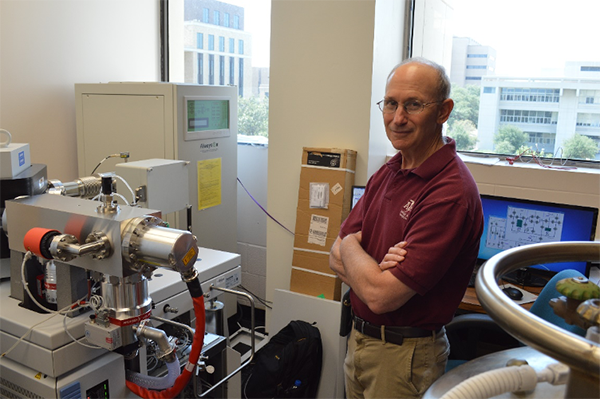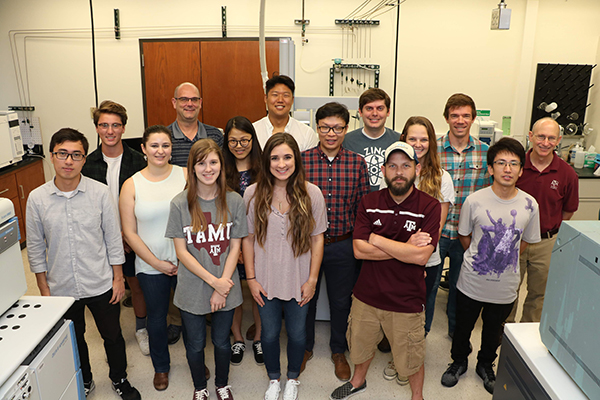Grossman Leading NSF-Funded Study Of Clumped Isotopes In Carbonate Minerals
Dr. Ethan Grossman will lead the project analyzing rare isotopes to study ancient ocean and sediment temperatures.
Jun 25, 2020


Dr. Ethan Grossman, professor and Michel T. Halbouty Chair in the Texas A&M University Department of Geology and Geophysics, recently received a $340,620 Earth Sciences (EAR) grant from the National Science Foundation (NSF) to study the kinetics of clumped isotope reordering in carbonate minerals.
Carbonate clumped isotopes is the name given to the field studying the co-occurrence of heavy oxygen (18O) and heavy carbon (13C) in the same molecules, Grossman said. Geoscientists have long used the proportion of heavy-to-light oxygen (18O vs. 16O) in fossils and microfossils to reconstruct temperatures of ancient oceans.
“In fact, this approach is a mainstay in studies of deep-sea cores collected by the International Ocean Discovery Program (IODP),” he explained. “Measurements of the proportion of heavy-to-light carbon (13C vs. 12C), collected at the same time as heavy oxygen data, are used to explore changes in the carbon cycle, especially those connected with climate change.”
Rare Isotopes Hold Clues To Ancient Temperatures
The clumping of heavy oxygen and heavy carbon in the same molecule is a rare happenstance, occurring in only 0.0067% of calcium carbonate molecules. The amount of clumping is dependent on temperature and serves as a thermometer for ancient oceans free of the assumptions of other methods, Grossman said.
However, deep burial of sediments and subsequent heating can reequilibrate or reorder the clumped isotope signatures.
Grossman and Dr. Sarbajit Banerjee, Professor and Davidson Chair in Science in the Texas A&M Department of Chemistry, and their students will reproduce this effect by heating different carbonate minerals in the laboratory at different temperatures for different durations to determine the rate of reordering.
Banerjee’s group will apply sophisticated modeling and measurement techniques to determine how changes in crystalline structure affect atom movement and consequently reordering rate, solid-state chemistry techniques Banerjee uses to help develop better battery technology. The refined kinetics data and model will allow more accurate reconstruction of ancient ocean temperatures, Grossman explained, and at the same time aid in hydrocarbon exploration by permitting more accurate representations of the burial temperatures of the sediments that generate fossil fuels.
Texas A&M Facilities Provide Cutting-Edge Capabilities
The clumped isotope analyses are performed in the Stable Isotope Geosciences Facility (SIGF) in the College of Geosciences.
“To make the measurement, powdered carbonate is placed in a series of vials and an automated system adds drops of acid to the sample, producing carbon dioxide,” Grossman said. “The carbon dioxide is transferred through a vacuum line using liquid nitrogen into a mass spectrometer.”
The clumped isotope instrument was purchased in 2017 as part of a $1 million award from the Chancellor’s Office to support mass spectrometry at Texas A&M. Located in the Eller Oceanography and Meteorology Building, SIGF was established in 2009 to provide students, faculty and staff with high-quality stable isotope measurements.
Grossman is co-director of SIGF along with Dr. Brendan Roark, Department of Geography, and together they operate the facility with Drs. Niall Slowey and Yige Zhang, Department of Oceanography, and Facility Manager Dr. Christopher Maupin.
With the wealth of data collected in this research, additional applications in future projects are also possible, Grossman said, including refining the temperature history of hydrocarbon-generating basins such as Texas’ Permian Basin, and determining ocean temperatures during the evolution of early animals.
Grossman and Banerjee’s grant will support two graduate students and one undergraduate student for the duration of the two-year project. Grossman believes that these research opportunities are invaluable to students because “no matter what the job, former students need problem-solving skills, and research experience is all about solving problems, learning technique is important — but solving problems is critical.”
By Amanda Hoth ’21

